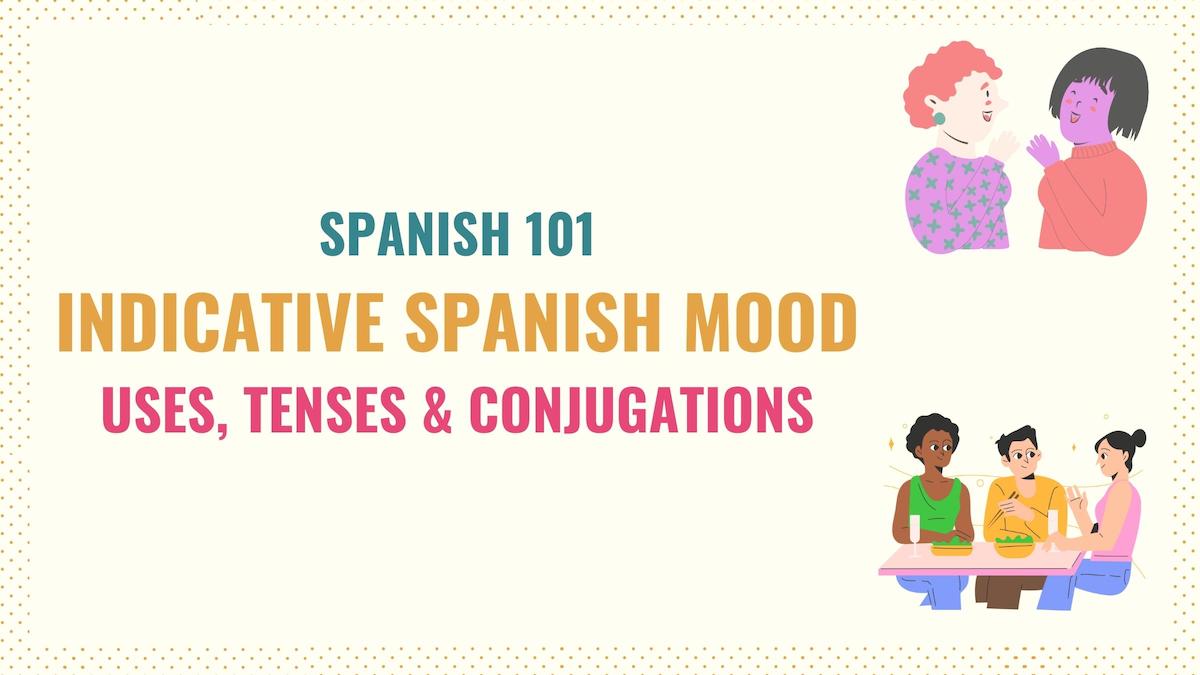In basic conversations, the indicative is the most common Spanish mood since it allows you to talk about current and past real-life situations. Simply put, the indicative Spanish mood is the foundation for effective communication.
So, in this guide, you’ll learn:
- What Is the Spanish Indicative Mood?
- Indicative Spanish Conjugations
- Indicative vs Subjunctive in Spanish
- Key Points
- Next Steps & Resources
As a beginner, the indicative mood is all you need to know to hold simple conversations. However, as you improve your command of Spanish, mastering the indicative is a crucial step to understanding how more advanced verb moods work.
So, let’s do this!
What Is the Indicative Mood in Spanish?
The indicative Spanish mood is used with statements that talk about factual information. Simply put, this mood refers to habits, facts, memories, descriptions, states, and actions we perceive or believe to be real.
For instance:
Mi casa es muy pequeña.
My house is very small.
A ellas les gustaron tus galletas.
They like your cookies.
Eran las 8 cuando llegaste.
It was 8 when you arrived.
The Spanish indicative relates to certainty and reality. Simply put, we use the indicative when the speaker considers the information as real or plausible, regardless of whether the statement is actually true or false.
La tierra es plana.
The Earth is flat.
Sus amigos vieron un ovni.
His friends saw a UFO.
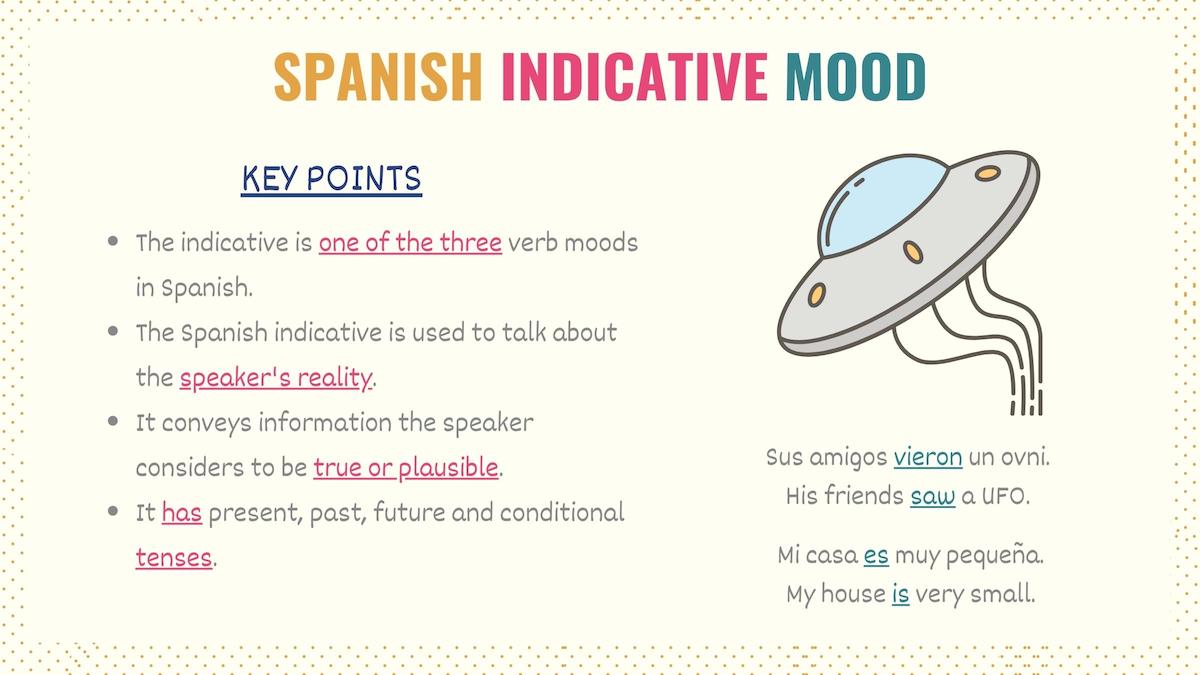
Indicative Spanish Conjugations
The Spanish indicative mood has different tenses to express the time frame when an action took place. These indicative tenses are:
- Present
- Preterite
- Imperfect
- Future simple
- Conditional simple
- Compound tenses
- Perfect tenses
- Progressive tenses
When conjugating a verb in Spanish, the indicative endings vary depending on the tense and the type of verb used in a sentence. In the following sections, you’ll find a summary of how to use and conjugate each indicative tense.
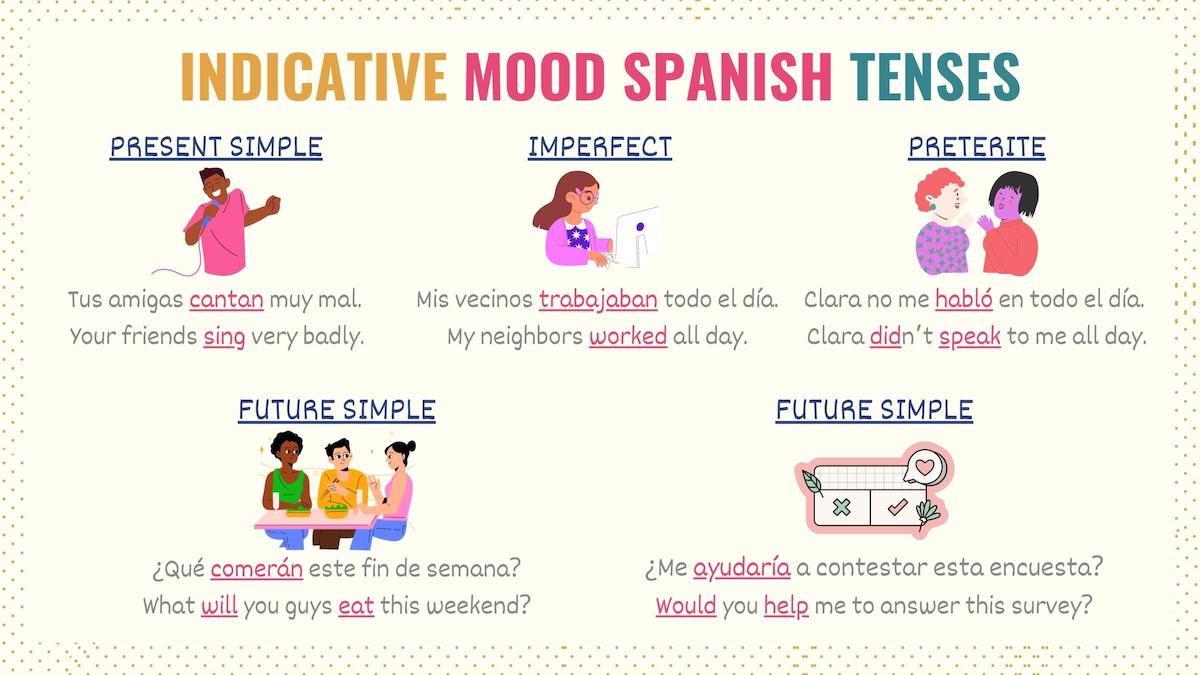
Spanish present indicative
As its name suggests, the present indicative tense refers to actions taking place in the present. This includes habits, current facts, and descriptions. You can see the endings used for regular verbs in the conjugation chart below:
And here are some sentences with the present indicative:
Tus amigas cantan muy mal.
Your friends sing very badly.
Nosotros nunca comemos galletas.
We never eat cookies.
¿Por qué escribes con pluma roja?
Why are you writing with a red pen?
Check my guide to the Spanish present indicative tense to learn more about conjugating irregular and stem-changing verbs in this tense.
Take Note: The present simple has two compound forms (the present progressive and the present perfect) that can help you place an action more precisely.
Preterite tense
The Spanish preterite is used to discuss completed past actions that ended at a specific time. Here is a graphic with the regular preterite tense conjugations:
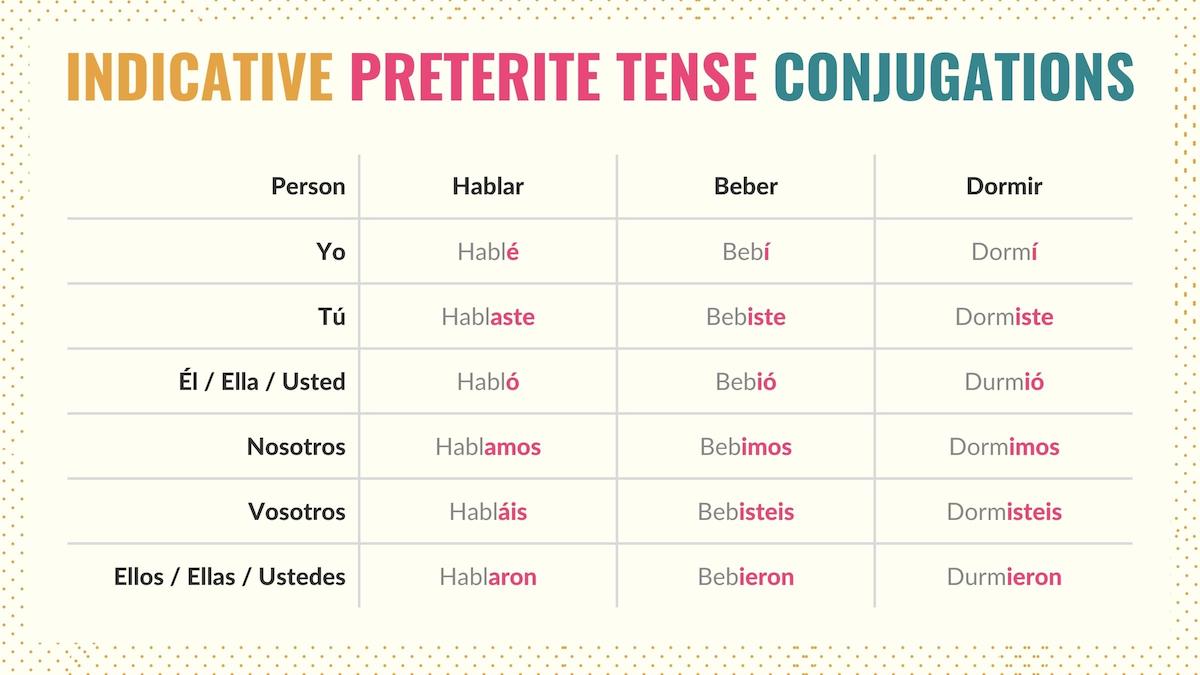
Check these sentences:
Dejé tus llaves en la mesa.
I left your keys on the table.
Ayer limpiamos las ventanas.
Yesterday we cleaned the windows.
Clara no me habló en todo el día.
Clara didn’t speak to me all day.
Take Note: Like the imperfect, the preterite tense has a progressive form known as past progressive, which allows you to emphasize that an action was in progress at some point in the past – Ayer estuve comiendo todo el día.
Spanish imperfect tense
The imperfect is another important past tense in Spanish that allows you to express habits and descriptions in the past. For instance:
La comida de la escuela era muy mala.
The school food was very bad.
Mis vecinos trabajaban todo el día.
My neighbors worked all day.
Shannon nunca tenía tiempo para relajarse.
Shannon never had time to relax.
These are the endings to form the Spanish imperfect indicative tense:
| Subject | -AR Verbs | -ER & -IR Verbs |
|---|---|---|
| Yo | Lavaba | Tenía |
| Tú | Lavabas | Tenías |
| Él, Ella, Usted | Lavaba | Tenía |
| Nosotros | Lavábamos | Teníamos |
| Vosotros | Lavabais | Teníais |
| Ustedes, Ellos, Ellas | Lavaban | Tenían |
Take Note: The imperfect conjugations are used to form the past perfect indicative tense in Spanish.
Future simple
In Spanish, the future indicative expresses that an event or state will happen in the future. Because of this, we often use it to refer to upcoming plans and actions. This indicative tense uses a set of endings for all –ar, -er, and –ir regular and irregular verbs.
- Yo: -é
- Tú: -ás
- Él/Ella/Usted: -á
- Nosotros: -emos
- Vosotros: -éis
- Ustedes/Ellos: -án
Here are some sentences using this indicative tense:
Mañana te sentirás mejor.
Tomorrow, you will feel better.
¿Qué comerán este fin de semana?
What will you guys eat this weekend?
No sé qué haré con este proyecto.
I don’t know what I will do with this project.
Take Note: The future perfect tense is the compound form of the future simple.
Conditional simple
The last Spanish indicative tense is the conditional simple, which is used to express politeness, conditions and hypothetical situations. These are the endings to form the conditional tense:
- Yo: -ía
- Tú: -ías
- Él/Ella/Usted: -ía
- Nosotros: -íamos
- Vosotros: -íais
- Ustedes/Ellos: -ían
And here are some real-life examples of how to use it:
Nos gustaría conocer a tu novio.
We would like to meet your boyfriend.
¿Me ayudaría a contestar esta encuesta?
Would you help me to answer this survey?
No cantaría en público a menos que me pagaran.
I wouldn’t sing in public unless you pay me.
Take Note: The Spanish conditional perfect is a compound form that allows you to form complex hypothetical sentences.
Spanish Indicative vs Subjunctive Mood
The indicative and subjunctive moods are often confused in Spanish. But there’s a significant difference between them.
In Spanish, we use the indicative to communicate factual information (things we believe to be true). Inversely, the subjunctive mood conveys the speaker’s wishes, doubts, suggestions, or feelings towards an action.
In summary, the indicative is objective, whereas the subjunctive is subjective. Check these examples:
| Indicative | Subjunctive |
|---|---|
| Él viene a visitarme mañana. Tomorrow, he comes to visit. | Espero que él venga a visitarme mañana. I hope he comes to visit tomorrow. |
Although in these examples the verb venir has the same English translation, there’s a subtle difference you must keep in mind. The indicative sentence informs a fact, we know that he’s coming tomorrow. However, the subjunctive example doesn’t have that degree of certainty.
In fact, with the subjunctive sentence, I’m not talking about facts. I’m instead expressing my hopes, feelings, and uncertainty. We do not know for sure if he’s coming; we only know what I hope he does.
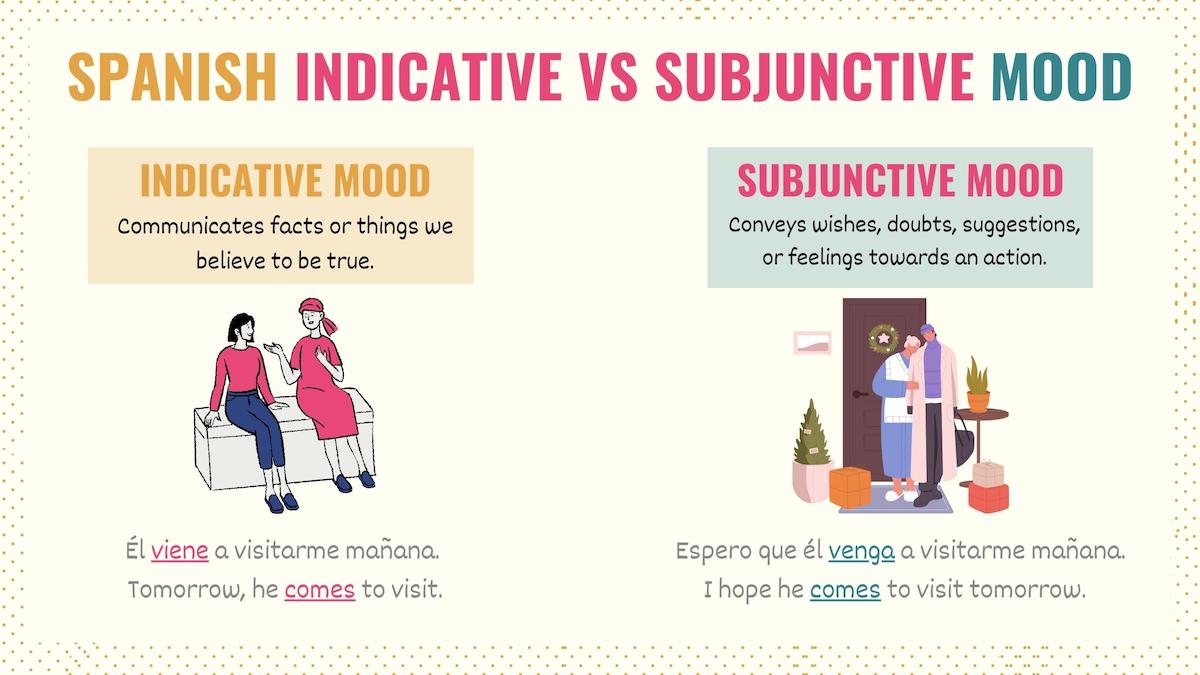
Key Points
The indicative Spanish mood is one of the foundations for effective communication. Here are some important key points you should never forget:
- Unlike the subjunctive mood, the indicative mood in Spanish relates to reality.
- It’s used to convey what the speaker believes to be factual information. Some real applications include talking about:
- Habits
- Descriptions
- Plans and memories
- Likes and dislikes
- The indicative uses different tenses to place an action at a specific point in time.
- The main indicative tenses are the present, preterite, imperfect, future, and conditional.
- These tenses also have progressive and perfect forms.
Spanish Indicative Mood Additional Resources
Mastering the Spanish indicative mood will not only improve your communication skills, but it will also build solid foundations for your command of the language. Here are some additional steps to learn more about this topic.
- Understand what Spanish moods are.
- Study the differences between the indicative and subjunctive.
- Learn the conjugation patterns and uses of the indicative tenses.
Here are some guides that will help you grasp the conjugation rules and uses of the different indicative tenses:
- Guide to Present Indicative in Spanish
- How to Use the Past Preterite Tense
- Guide to the Spanish Imperfect Indicative Tense
- Difference Between Preterite vs Imperfect
- Guide to the Spanish Future Tense
- How to Use & Form the Conditional Tense
Download the Spanish Indicative Mood PDF
Spanish tenses are grouped into moods, which are the lesser known and more abstract concept in learning Spanish verb conjugation and grammar. Now that you’ve learned how the indicative Spanish mood works, you can download a free copy of the PDF for this guide with all the graphics and key points so you can refresh your knowledge on it at your convenience.

